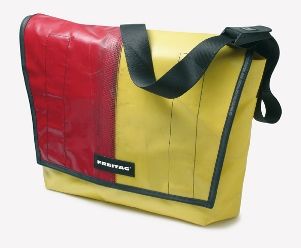In 1993, brothers Daniel and Markus Freitag made their first bag from used truck tarpaulins. Since then, Freitag has become an urban fashion label in Switzerland and beyond, and now produces about 400,000 bags and accessories annually. An essential aid in their work is a special METTLER TOLEDO scale.
It all started in an apartment in Zürich. Markus Freitag had been looking for a durable, weatherproof messenger bag for some time. One day, inspiration struck as he watched passing trucks from his kitchen window. Together with his brother, he cut the first Freitag bag out of an old truck tarpaulin, attached a second-hand car seatbelt as the strap, and used a bicycle inner tube for the edging.
A Swiss Success Story
After their prototype passed the test of endurance as a bicycle messenger bag, Daniel and Markus made more bags for their friends. Then they made bags for friends of friends. And the two designers ultimately started their own business. Today Freitag has around 160 employees, most of whom work at the headquarters in Zurich. The majority of the Freitag bags are designed, cut and dispatched from here.
In the Beginning Was Tarpaulin
Before reaching the production line, the truck tarpaulins go through several work steps. First Freitag employees remove eyelets, buckles and belts from the huge tarpaulin sheets. The tarpaulins then go through several courses of cleaning in special washing machines before employees cut the tarps on a large table. The cut pieces of tarp are then stacked, bundled and weighed before being sent to the warehouse. The production employees need a weighing table for this, a special one that MT developed specifically for Freitag.
Creative Solution Tailored to the Customer's Requirements
Reto Zahner is a sales consultant in the industrial sector and has been looking after Freitag for five years. He worked together with the head of bag production to develop the idea of the mobile weighing table.


The table consists of a metal frame and the PFA 574-D300 floor scale, which is frequently used in industry for weighing euro pallets. However, using the scale on the floor is not an option for Freitag, as Reto explains. "Our customer cuts the truck tarps, stacks them on a table, and then wants to weigh them directly on the table. Why should he have to move the tarps from the table back to the floor in order to be weighed? Weighing and bundling the tarps on the table is more practical and nicer on your back."
Reto drew the first freehand sketches of the weighing table at his desk at home. Later he brought his idea to a metalworker who created a customized frame with four wheels. The tabletop functions as the load plate for the scale in this design. The ICS425a terminal is fixed to the table. There is also a laptop holder. "It is especially important for our customers that the scale is mobile, so it can be put away when not in use or moved to another location to be used there. Space is tight in the production area," acknowledges Reto.
But why does Freitag need a floor scale with a weighing capacity of up to 300 kilograms just to weigh pieces of tarp? "Mainly because of the size of the platform," Reto Zahner explains. With approximately one square meter of space, the platform provides exactly the right amount of space for tying up the tarp bundles and weighing them at the same time. Before the bundled tarps are sent to the warehouse, they are recorded using the Balance Link program. The weight can be used to later determine the size of the tarps. "At Freitag, it is not as easy as saying, 'At this table we have three square meters of yellow material.' Instead, all tarps are recorded according to their weight and color scheme," Reto explains.
Sustainable Design
For a company that makes all its products from used materials it is not surprising that sustainability plays an important role in the entire value-added chain. The truck tarps are washed using rainwater before being transformed into bags. Freitag uses leftover materials that are not used for making bags to make smaller accessories such as cell phone cases or wallets. The company has already received a number of awards and honors for its focus on sustainability and unique design. One such honor is the inclusion of the original Freitag model, the F13 Top Cat, in the design collection of the Museum of Modern Art (MoMA) in New York.

